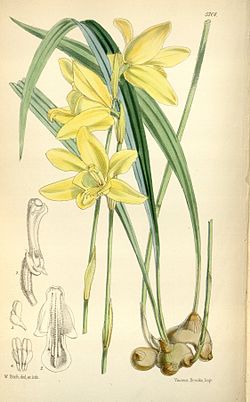Ipsea: Difference between revisions
No edit summary |
No edit summary |
||
| (2 intermediate revisions by 2 users not shown) | |||
| Line 1: | Line 1: | ||
{{SPlantbox | {{SPlantbox | ||
|familia=Orchidaceae | |||
|genus=Ipsea | |||
|habit=orchid | |||
|lifespan=perennial | |||
|exposure=part-sun | |||
|water=moderate | |||
|features=flowers | |||
|flower_season=early winter, mid winter, late winter | |||
|flowers=yellow | |||
|Temp Metric=°F | |Temp Metric=°F | ||
|jumpin=If this plant info box on watering; zones; height; etc. is mostly empty you can click on the edit tab and fill in the blanks! | |jumpin=If this plant info box on watering; zones; height; etc. is mostly empty you can click on the edit tab and fill in the blanks! | ||
|image= | |image=Ipsea speciosa.jpg | ||
|image_width= | |image_width=180 | ||
|image_caption=''Ipsea speciosa'', Illustration. | |||
}} | }} | ||
'''''Ipsea''''' is a [[genus]] of the [[Orchid]] [[family (biology)|family]] ([[Orchidaceae]]), [[endemic (ecology)|endemic]] to [[India]], [[Sri Lanka]] and [[North America]]. | |||
{{Inc| | {{Inc| | ||
Ipsea (fancied resemblance to ips, a cynip insect or a worm). Orchidaceae. Two or 3 terrestrial E. Indian pseudobulbous orchids, allied to Pachystoma, with which it has been united: lvs. long, narrow and plicate: scape sheathed; fls. few, large, highly colored. I. speciosa, Lindl. (Pachystoma speciosum, Reichb.). Deciduous, tuberous-rooted, with erect scapes to 18 in. high: lvs. 5-8, long-petioled, 6-10 in. long: fls. several, bright yellow, fragrant, 2-3 in. diam., the lip oblong, with side lobes triangular and middle lobe obovate: pseudobulbs tufted. Ceylon | Ipsea (fancied resemblance to ips, a cynip insect or a worm). Orchidaceae. Two or 3 terrestrial E. Indian pseudobulbous orchids, allied to Pachystoma, with which it has been united: lvs. long, narrow and plicate: scape sheathed; fls. few, large, highly colored. I. speciosa, Lindl. (Pachystoma speciosum, Reichb.). Deciduous, tuberous-rooted, with erect scapes to 18 in. high: lvs. 5-8, long-petioled, 6-10 in. long: fls. several, bright yellow, fragrant, 2-3 in. diam., the lip oblong, with side lobes triangular and middle lobe obovate: pseudobulbs tufted. Ceylon.—Blooms in winter. To be potted in fibrous loam, peat and leaf-mold, and rested alter growth. | ||
}} | |||
==Cultivation== | |||
===Propagation=== | |||
===Pests and diseases=== | |||
==Species== | |||
*''[[Ipsea malabarica]] | |||
*''[[Ipsea speciosa]] | |||
*''[[Ipsea thailandica]] | |||
*''[[Ipsea thomsoniana]] | |||
*''[[Ipsea wrayana]] | |||
==Gallery== | |||
<gallery perrow=5> | |||
Image:Upload.png| photo 1 | |||
Image:Upload.png| photo 2 | |||
Image:Upload.png| photo 3 | |||
</gallery> | |||
==References== | |||
<references/> | |||
*[[Standard Cyclopedia of Horticulture]], by L. H. Bailey, MacMillan Co., 1963 | |||
<!--- xxxxx *Flora: The Gardener's Bible, by Sean Hogan. Global Book Publishing, 2003. ISBN 0881925381 --> | |||
<!--- xxxxx *American Horticultural Society: A-Z Encyclopedia of Garden Plants, by Christopher Brickell, Judith D. Zuk. 1996. ISBN 0789419432 --> | |||
<!--- xxxxx *Sunset National Garden Book. Sunset Books, Inc., 1997. ISBN 0376038608 --> | |||
==External links== | |||
*{{wplink}} | |||
* | |||
}} | |||
{{stub}} | |||
__NOTOC__ | |||
Latest revision as of 20:21, 25 March 2010
| Ipsea subsp. var. | ||||||||||||||||||||||||||||||||||||||||||||||||||||||||
|---|---|---|---|---|---|---|---|---|---|---|---|---|---|---|---|---|---|---|---|---|---|---|---|---|---|---|---|---|---|---|---|---|---|---|---|---|---|---|---|---|---|---|---|---|---|---|---|---|---|---|---|---|---|---|---|---|

|
|
| ||||||||||||||||||||||||||||||||||||||||||||||||||||||
| ||||||||||||||||||||||||||||||||||||||||||||||||||||||||
Ipsea is a genus of the Orchid family (Orchidaceae), endemic to India, Sri Lanka and North America.
| Standard Cyclopedia of Horticulture |
|---|
|
Ipsea (fancied resemblance to ips, a cynip insect or a worm). Orchidaceae. Two or 3 terrestrial E. Indian pseudobulbous orchids, allied to Pachystoma, with which it has been united: lvs. long, narrow and plicate: scape sheathed; fls. few, large, highly colored. I. speciosa, Lindl. (Pachystoma speciosum, Reichb.). Deciduous, tuberous-rooted, with erect scapes to 18 in. high: lvs. 5-8, long-petioled, 6-10 in. long: fls. several, bright yellow, fragrant, 2-3 in. diam., the lip oblong, with side lobes triangular and middle lobe obovate: pseudobulbs tufted. Ceylon.—Blooms in winter. To be potted in fibrous loam, peat and leaf-mold, and rested alter growth.
|
Cultivation
Propagation
Pests and diseases
Species
Gallery
-
photo 1
-
photo 2
-
photo 3
References
- Standard Cyclopedia of Horticulture, by L. H. Bailey, MacMillan Co., 1963
External links
- w:Ipsea. Some of the material on this page may be from Wikipedia, under the Creative Commons license.
- Ipsea QR Code (Size 50, 100, 200, 500)
